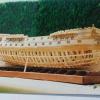-
Posts
224 -
Joined
-
Last visited
Reputation Activity
-
 mij reacted to EdT in Young America 1853 by EdT - FINISHED - extreme clipper
mij reacted to EdT in Young America 1853 by EdT - FINISHED - extreme clipper
Young America - extreme clipper 1853
Part 22 – Cant Frame Scores
American Clipper Note: In a departure from the historical notes on the stirring adventures of these ships in service, I thought it would be a good idea to comment on some construction aspects as well. Since the forward framing is set to begin on the model, some description of that might be appropriate.
The bulk of the transverse hull framing on these ships – and most ships – consisted of full breadth “square frames” whose lower timbers rested on and were bolted through the keel. As the forward (or aft) end of the ship was approached and the v-shape of the floor timbers that crossed the keel became more acute, a point would be reached where naturally grown “compass timber” could not be found to make these pieces. At that point – on these ships – “half frames” were installed. These were still square to the keel, but were made in separate assemblies for each side of the ship and were bolted horizontally through each other and the vertical deadwood/keelson structure – the backbone of the hull. Further forward, as the bevels on these frames became more pronounced, it would no longer be possible to bolt the sections of each half frame pair together with bolts “normal” or at a right angle to the face of the frame, without the bolt being exposed through the beveled side. At this point “cant frames” were used to complete the bow (or stern) framing. These were also bolted to the deadwood but were angled – canted – forward to reduce their bevel and allow the pairs to be bolted together securely. Since every ship had a different shape and since timber availability varied, it seems likely that these break points were set for each ship in the mold loft as the frame patterns were drawn out and timber supplies known.
I applied this assumption in lofting the frames for the Young America model.
Before starting work on the next frames to be installed – the forward half-frames – the “scores” for the cant frames needed to be cut while there was still enough room to do this. These scores provided important support to the angled cant frames by allowing them to be inset into the keelson/deadwood – rather than depending on bolts alone.
The vertical joint faces of each half-frame and the cant frame extend up from the bearding line to the cutting down line. The bearding line defines the point at each frame where the frame profile narrows down to the face of the 16” wide keelson/deadwood. The cutting down line defines the upper edge of the inboard faces of the frames at the keelson/deadwood.
The first picture shows a template - made from the drawing - being used to trace the bearding line on the model.
A similar template was used to trace the cutting down line above this. The next picture shows the vertical lines of the scores being marked using a Plexiglas square made to slide clear of the keel retaining strips on the base board.
These lines define the extent of each of the five cant frame joint faces – the area to be inset. The next picture shows the first score on the starboard side cut out.
Since I plan to plank the starboard side of the model, I started this risky chiseling process on that side for practice. Planking is a great way to hide framing mistakes.
I will not describe the full process here, but the next few pictures show it generally. In the first picture the vertical lines are being scored with a knife using very light cuts.
In the next picture, a chisel is being used to cut into the deadwood at the bottom – just above the bearding line. The line just above the chisel is the joint line between the apron and the deadwood.
The score itself was then pared out with various small chisels. The next picture shows some of that work in progress.
The last picture shows three of the five cant frame scores essentially finished. Two more to go – on this side.
Although it was more difficult to manage this work in place, I did it this way because the overall hull assembly is still quite weak and I did not want to risk setting it up on the workbench for that reason.
Next: on to the half frames.
Ed
-
 mij reacted to Q A's Revenge in Italian needle rasps
mij reacted to Q A's Revenge in Italian needle rasps
Bit pricey but they look nice.
http://www.rutlands.co.uk/sp+woodworking-hand-tools-carving-tools-needle-files-cabinet-makers-needle-rasp-flat-160mm-x-no-2-cut+dk7910
-
 mij reacted to Modeler12 in How to fasten a line to a belaying pin on a real ship and model.
mij reacted to Modeler12 in How to fasten a line to a belaying pin on a real ship and model.
When I boarded a square rigged sailing ship, I asked one of the crew members to show me how to belay a line. The video below shows how this was done and how I adapted the procedure for my modeling. The technique is updated from an earlier video I showed, and now includes how I made the coils shown in the picture below.
The nice thing with this method is that now I don't coat the whole line with glue, only the top of the loop. This allows me to adjust the lay of the coil when installing it on the model. Since each coil is made individually, it takes me about five minutes per coil. But notice the difference between the 'old' coils (top left in the picture below) and the current ones.
Here is the video
http://www.youtube.com/watch?v=KztQr5Z2BdI
-
 mij got a reaction from Archi in HMS Sussex by mij - Scale 1:48
mij got a reaction from Archi in HMS Sussex by mij - Scale 1:48
This is the 1st stage of fairing the outside and inside of the hull using a long neck grinder.
This is a fabulous tool to use, but a word of CAUTION, this tool can ruin your model if your not careful.
mij
-
 mij reacted to druxey in HMS Sussex by mij - Scale 1:48
mij reacted to druxey in HMS Sussex by mij - Scale 1:48
Now that is a major decision! Not many folk would get so far along, then decide to re-start. My hat off to you, mij.
-
 mij reacted to flying_dutchman2 in Utrecht 1746 by flying_dutchman2 - FINISHED - Scale 1:48 - Dutch Statenjacht
mij reacted to flying_dutchman2 in Utrecht 1746 by flying_dutchman2 - FINISHED - Scale 1:48 - Dutch Statenjacht
This boat will be built from ready pre-cut wood as I do not have the equipment to create a plank from a large piece of wood.
I have some very knowledgeable people in my Nautical club and they have given me numerous suggestion what wood I can use for what part of the boat.
I am finishing up taping the frames to the wood.
So I do have a question:
If you build a POF, why cut the frames up into futtocks (sp) and then plank both the outside and the inside of the boat and add a deck? Is it a sawing exercise?
-
 mij reacted to Mike 41 in USS Pennsylvania 1837 by Mike 41 - Scale: 1:64 - Cross-Section
mij reacted to Mike 41 in USS Pennsylvania 1837 by Mike 41 - Scale: 1:64 - Cross-Section
These photos show the well room and shot lockers installed in the model.
-
 mij reacted to overdale in Baby Gar 1929 by overdale - FINISHED - scale 1/12 - Speedboat
mij reacted to overdale in Baby Gar 1929 by overdale - FINISHED - scale 1/12 - Speedboat
Starting the final assembly.
-
 mij reacted to ianmajor in What do you use your mill for ?
mij reacted to ianmajor in What do you use your mill for ?
Bob,
I use my milling machine for a whole raft of things both in milling and drilling jobs. The x-y table is a real bonus where you can, for example, drill an accurate pattern of holes, you can mount a blunt pin in the chuck and use it to press quite quickly an accurate pattern of cosmetic rivets. Using collets it is much easier to drill small holes (below 1mm dia) than using some form of hand drill - I break fewer bits with my mill - I adjust the x-y table to the desired position then lock it to avoid lateral stress on the bit.
For milling it is great for accurate rebates. Recently I used it to make a wooden jig to assemble a companion way ladder. This involved milling the wood to the correct width then cutting equally spaced slots at 45 degrees to hold the ladder treads.
There is little that you can do on a mill that you can't do with hand tools but the mill makes the tasks a lot easier to do.
For me it is one of the tools that I think "how did I cope without it?"
-
 mij got a reaction from tarbrush in HMS Sussex by mij - Scale 1:48
mij got a reaction from tarbrush in HMS Sussex by mij - Scale 1:48
This is the 1st stage of fairing the outside and inside of the hull using a long neck grinder.
This is a fabulous tool to use, but a word of CAUTION, this tool can ruin your model if your not careful.
mij
-
 mij reacted to SaturnV in SaturnV's 1:48 Full Framed Triton Build
mij reacted to SaturnV in SaturnV's 1:48 Full Framed Triton Build
Made progress on frames this weekend. Frames are just placed in their reletive positions - not glued in place yet.
Enjoying the work very much.
Richard
-
 mij reacted to Jeronimo in HMS Sussex by mij - Scale 1:48
mij reacted to Jeronimo in HMS Sussex by mij - Scale 1:48
Hi mij,
a very nice ship.
I wish much success with building the model.
Karl
-
 mij got a reaction from rtropp in HMS Sussex by mij - Scale 1:48
mij got a reaction from rtropp in HMS Sussex by mij - Scale 1:48
Sanding the forward frames
Milling the stem scarf
Forward frames fitted to the keel and deadwood
This is one of my main machines, an old 3 wheel, 104" INCA bandsaw.
mij
-
 mij got a reaction from Archi in HMS Sussex by mij - Scale 1:48
mij got a reaction from Archi in HMS Sussex by mij - Scale 1:48
Here are some of my tools I use for models.
SIP bobbin sander
Walker Turner drill presss, and Proxxon lathe
Proxxon mill/drill
Proxxon bench saw
A Proxxon small bench saw
Draper 16" fretsaw
mij
-
 mij got a reaction from mtaylor in HMS Sussex by mij - Scale 1:48
mij got a reaction from mtaylor in HMS Sussex by mij - Scale 1:48
This is the 1st stage of fairing the outside and inside of the hull using a long neck grinder.
This is a fabulous tool to use, but a word of CAUTION, this tool can ruin your model if your not careful.
mij
-
 mij got a reaction from Pete38 in HMS Sussex by mij - Scale 1:48
mij got a reaction from Pete38 in HMS Sussex by mij - Scale 1:48
This is the 1st stage of fairing the outside and inside of the hull using a long neck grinder.
This is a fabulous tool to use, but a word of CAUTION, this tool can ruin your model if your not careful.
mij
-
 mij got a reaction from Archi in HMS Sussex by mij - Scale 1:48
mij got a reaction from Archi in HMS Sussex by mij - Scale 1:48
Started to build up the frames.
The first picture is the full frame drawn on paper with the floor timber and the top timber tacked to the paper using Copydex.
This picture shows the 1st futtock glued to the floor timber and the top timber using Titebond and held in position with 1bl weights.
This picture shows the complete frame, slightly over size for fairing.
-
 mij got a reaction from NMBROOK in HMS Sussex by mij - Scale 1:48
mij got a reaction from NMBROOK in HMS Sussex by mij - Scale 1:48
I`ve been building model ships and using power tools on them for a very long time now, and I believe if you fill confidant in yourself, you must give it a try, or your skill level stay as they are.
Thanks for the nice comment.
mij
-
 mij got a reaction from WackoWolf in HMS Sussex by mij - Scale 1:48
mij got a reaction from WackoWolf in HMS Sussex by mij - Scale 1:48
I`ve been building model ships and using power tools on them for a very long time now, and I believe if you fill confidant in yourself, you must give it a try, or your skill level stay as they are.
Thanks for the nice comment.
mij
-
 mij got a reaction from Jeronimo in HMS Sussex by mij - Scale 1:48
mij got a reaction from Jeronimo in HMS Sussex by mij - Scale 1:48
Started to build up the frames.
The first picture is the full frame drawn on paper with the floor timber and the top timber tacked to the paper using Copydex.
This picture shows the 1st futtock glued to the floor timber and the top timber using Titebond and held in position with 1bl weights.
This picture shows the complete frame, slightly over size for fairing.
-
 mij got a reaction from Jeronimo in HMS Sussex by mij - Scale 1:48
mij got a reaction from Jeronimo in HMS Sussex by mij - Scale 1:48
This is the 1st stage of fairing the outside and inside of the hull using a long neck grinder.
This is a fabulous tool to use, but a word of CAUTION, this tool can ruin your model if your not careful.
mij
-
 mij got a reaction from NMBROOK in HMS Sussex by mij - Scale 1:48
mij got a reaction from NMBROOK in HMS Sussex by mij - Scale 1:48
This is the 1st stage of fairing the outside and inside of the hull using a long neck grinder.
This is a fabulous tool to use, but a word of CAUTION, this tool can ruin your model if your not careful.
mij
-
 mij got a reaction from gjdale in HMS Sussex by mij - Scale 1:48
mij got a reaction from gjdale in HMS Sussex by mij - Scale 1:48
This is the 1st stage of fairing the outside and inside of the hull using a long neck grinder.
This is a fabulous tool to use, but a word of CAUTION, this tool can ruin your model if your not careful.
mij
-
 mij got a reaction from giampieroricci in HMS Sussex by mij - Scale 1:48
mij got a reaction from giampieroricci in HMS Sussex by mij - Scale 1:48
This is the 1st stage of fairing the outside and inside of the hull using a long neck grinder.
This is a fabulous tool to use, but a word of CAUTION, this tool can ruin your model if your not careful.
mij
-
 mij got a reaction from druxey in HMS Sussex by mij - Scale 1:48
mij got a reaction from druxey in HMS Sussex by mij - Scale 1:48
This is the 1st stage of fairing the outside and inside of the hull using a long neck grinder.
This is a fabulous tool to use, but a word of CAUTION, this tool can ruin your model if your not careful.
mij











